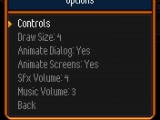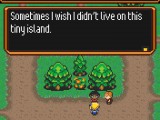I recently stumbled upon a really good video game trailer:
The above video, then, is a launch trailer for Brushfire Games’ new indie game Shipwreck. It is as WYSIWYG as you get! In buying this new game, you get the following:
- Neat and tidy pixel graphics
- Atmospheric console-style ‘retro’ music
- Well-balanced, honed gameplay
- Fun mechanics and a good difficulty curve
- Zelda! Zelda! Link! Link!
- I.e., A solid little game.
Interested? Read on, for more commentary on the game’s mechanics, qualities, and genre:
 In Shipwreck, players wash up on the stormy shores of a tiny island, and soon end up trying to save the islanders from a ghostly curse that prevents anyone from leaving – including the player! The village’s mayor sends players off on an adventure to recover four magical seals, to break a curse – and to be allowed escape off the island they are now stranded on.
In Shipwreck, players wash up on the stormy shores of a tiny island, and soon end up trying to save the islanders from a ghostly curse that prevents anyone from leaving – including the player! The village’s mayor sends players off on an adventure to recover four magical seals, to break a curse – and to be allowed escape off the island they are now stranded on.
In other words: Shipwreck is as Zelda-like as it gets. For a pixel-perfect comparison, I would point at the classic Gameboy Color Zeldas – Link’s Awakening DX, Oracle of Ages, and Seasons. In Shipwreck, players will traverse the island, find and use different items and weapons to progress through the game’s overworld and dungeons. Should you be interested in a more detailed analysis of the Zelda genre, you can always look up Jeremy Parish for more information; in the meantime, we’ll just agree that the Zelda-like hallmarks are all there: 32×32 tiles, the top-down perspective, the overworld-dungeon structure, a sword and a shield, heart containers, and bushes.
 Yes, bushes! One of the immediately noticeable features of the trailer above is the protagonist’s humongous sword. Slashing up a bush for the very first time made me very much chuckle out loud. Giving those bushes that a-thwackin’, in search of hearts and gold, is always such a familiar moment, a feel-good experience, a reunion.
Yes, bushes! One of the immediately noticeable features of the trailer above is the protagonist’s humongous sword. Slashing up a bush for the very first time made me very much chuckle out loud. Giving those bushes that a-thwackin’, in search of hearts and gold, is always such a familiar moment, a feel-good experience, a reunion.
The sword, then? It is a Big ‘Un indeed, and very much defines Shipwreck’s smooth-sailing, well-defined gameplay. While both its arc and reach are very, large, and as such, rather forgiving. At the same time, the game’s play is actually much more about blocking, positioning, and movement, rather than actually hitting monsters right on the kisser. Don’t get me wrong, that is what you do, but I was left with the feeling that playing the game was relatively multifaceted.
 Shipwreck has a fine difficulty curve, too; things get difficult enough quite fast, but never too difficult. If you do run out of hearts, and apples, or loaves of bread (Shipwreck’s healing consumables), the worst thing that can happen is being teleported to the entrance of a particular dungeon.
Shipwreck has a fine difficulty curve, too; things get difficult enough quite fast, but never too difficult. If you do run out of hearts, and apples, or loaves of bread (Shipwreck’s healing consumables), the worst thing that can happen is being teleported to the entrance of a particular dungeon.
The inventory system is just as tried and true, then, as the rest of the game. Players select any combination of just two items from their inventory for active use, “x” and “c” for left and right, respectively. Soon enough the game becomes all about juggling this selection of two items for the best possible combination. The baseline combination, of course, is a sword and a shield, but you’ll soon get access to more items and weapons, too.
Though Shipwreck seldom forces you to do things – using a lamp in pitch-black darkness is one -, it makes perfect sense to approach the game’s rooms as simplistic puzzles, trying to think up the best-suited set of two items (or more!) for the current dungeon, room, or fight. Just to name one example, it may be sometimes smarter to use the shield almost exclusively, compared to using a primary weapon.
The Zelda-style two-slot usable system is actually a surprisingly advanced mechanic, given that the two-slot limit results in many different combinations. It is also a concept that utilizes its limits maximally, something that Shipwreck does this very well overall.
(Indie games as art of imitation and limitation? Yes.)
 The graphics are joyful, and solid, and while the game’s options are otherwise limited, I was able to play in windowed mode, 4x the game’s resolution. I prefer to do this for a multitude of reasons, but chiefly to really see the pixel detail. Low-resolution games form a perfect counterpoint to the rat race that exists between consoles and the PC, to the current trends of higher-and-higher resolutions, more detailed textures, and exponentially growing amounts of polygons.
The graphics are joyful, and solid, and while the game’s options are otherwise limited, I was able to play in windowed mode, 4x the game’s resolution. I prefer to do this for a multitude of reasons, but chiefly to really see the pixel detail. Low-resolution games form a perfect counterpoint to the rat race that exists between consoles and the PC, to the current trends of higher-and-higher resolutions, more detailed textures, and exponentially growing amounts of polygons.
When I was young, we wanted our pixels to be as small as possible. Now, with games like Shipwreck? The bigger the better! It’s great to be able to really see the artistic definition in magnified size and shape.
 Zelda-likes definitely live and die by their dungeon design, and I’m happy to report that much of Shipwreck’s is tight, clever, and even welcoming. Only end-game dungeons do begin to exhibit a smidgeon of prolongment, as I did catch myself moaning about the floor plans a little bit. That being said, the game’s automap system is good, only not having stairs marked on them made the game a little bit more confusing than it perhaps should have, or could have, been.
Zelda-likes definitely live and die by their dungeon design, and I’m happy to report that much of Shipwreck’s is tight, clever, and even welcoming. Only end-game dungeons do begin to exhibit a smidgeon of prolongment, as I did catch myself moaning about the floor plans a little bit. That being said, the game’s automap system is good, only not having stairs marked on them made the game a little bit more confusing than it perhaps should have, or could have, been.
Controls are fine, both on the keyboard, and on an X360 controller. My one real complaint relates to the game’s installer package, which forcibly pushes the game into “Program Files” on Windows. In this day and age, I think, most people prefer a zip file with an executable. I firmly believe that indie games should pride themselves on being as agile, portable, and platform-agnostic as possible!
Another aspect that absolutely bears mention is the landscape in which Shipwreck is being released in. After all, in this current era of long-lost innocence, many critics and players display a broader aversion to games that ‘play’ themselves ‘straight,’ as if this was no longer quite permitted. Every action, and every move, must now be committed with full knowledge – or at the very least a kind of showmanship of this fact.
We’ve all taken a bite of that pesky apple. (Apples aren’t pesky in Shipwreck).
 More specifically, the top-down Zelda-like changed somewhat after the release of Anodyne. Sure, especially fangames, and even newer AAA RPGS have long now had a meta-level that I feel many RPG players are very, very partial to. Saying this, I too went into Shipwreck fully expecting this meta-commentary dimension, a modicum of subversiveness, that postmodern slant, that knowing glint of the eye, that shared nod, a treatment of the genre’s constraints and possibilities…
More specifically, the top-down Zelda-like changed somewhat after the release of Anodyne. Sure, especially fangames, and even newer AAA RPGS have long now had a meta-level that I feel many RPG players are very, very partial to. Saying this, I too went into Shipwreck fully expecting this meta-commentary dimension, a modicum of subversiveness, that postmodern slant, that knowing glint of the eye, that shared nod, a treatment of the genre’s constraints and possibilities…
…no such thing! Nowhere! Not once. Everything’s taken for granted – even the game’s classic “use-talk” responses are as banal as they get! – and played completely straight. In doing this, Shipwreck managed to break my expectations big time. Expecting something at every turn, and then never once receiving it, must be considered something of a weird success.
This isn’t to say the game isn’t genre-conscious enough, in other ways, taking full advantage of all the proven good things of the Zelda-like. Shipwrecked is short, sweet, and studious, a well-designed replication of the Zelda topos. It’s little else; it’s not big, it’s not bold, but it’s pretty good indeed.
Priced, exactly-right, at $3.00, Shipwreck is available now, for Windows, from a Humble Store widget, and for the XBOX360 on the Xbox Live Indie Games. Developers Brushfire Games are also running an ongoing Greenlight campaign to get the game on Steam.
A copy was provided for the purpose of this review.



0 Comments
Recommended Comments
There are no comments to display.